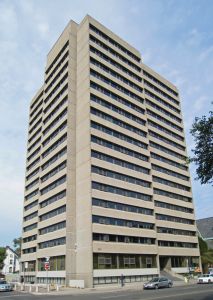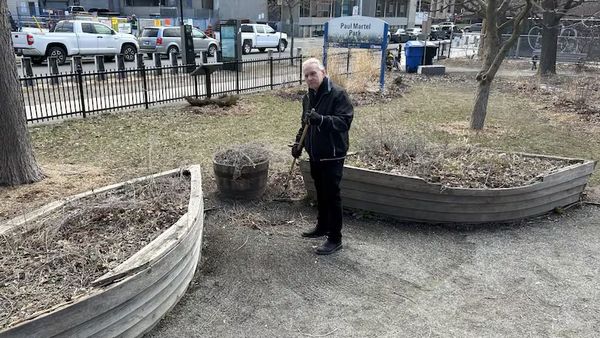Maybe something can be learned from the words and experience of almost 50 years ago.
As was reported in Vaba Eestlane (October 12, 1968), the organization had acquired construction funding from the Central Mortgage and Housing Corporation (CMHC) for 90% of the projected $3.3 million budget. (See Vaba Eestlane) Cost overruns and other factors ballooned the budget and created a shortfall. When 4 other building projects financed by CMHC and managed by the same group of developers ran into their own financial peril, some publicly questioned whether these cash crises were manufactured by manipulation. Nevertheless, a prominent Estonian-Canadian project was under financial stress and their deficit, which was equivalent to 3% (or $100,000.00) of their construction budget, needed to be remedied. On July 15, 1970 a private corporation came to the rescue. In exchange for their loan, the lender acquired a lease agreement for 3,577 square feet of prime real estate space for a term of 50 years for a grand total of $50.00. (See SMS Lease) Yes, one dollar per year.
Advertisement / Reklaam
Advertisement / Reklaam
A building that carries an Estonian name and represents an Estonian-Canadian legacy was saved. All it cost was a 50 year lease agreement. Crisis averted… perhaps. What did the organization really pay for this timely solution? Why couldn’t the loan-lease just be a straight loan? Why couldn’t the term be shorter? The lender’s return on investment was realized in less than 5 years because they reportedly sublet the space for $22,535 per year. If the loan-lease agreement was for a 5, 7 or even a 10 year term, the organization could have reaped the benefits of their own commercial tenants, accumulated equity and built a healthy reserve fund after the loan was satisfied. Instead the space has only brought in $47.00 of revenue since 1970 and the organization’s reserve fund is basically non-existent. Even if you include the $100,000 “loan” as revenue, then the space only brought in $2,001 per year; that’s 56 cents per square foot per year. At that point, even a high interest loan could have been manageable considering the revenue the space should have generated.
Merriam-Webster’s dictionary defines a usage of the word equity as “a risk interest or ownership right in property.” The terms of the lease show the lender gained significant ownership rights over 3,577 square feet of ground floor space and acquired those rights with relatively little inherent risk. On the other hand, the lender’s agreement washed away the organization’s ability to maximize the value of prime commercial space for 50 years. It is impossible to determine with any certainty how much the organization’s equity or liquidity was affected. There are so many scenarios that could have played out in the normal course of business that the revenue options and estimates are virtually endless. Whatever reasonable options one might pick, what is certain is that the space should have made more than $100,050.00 over 5 decades.
Perhaps the best method to measure the impact of the loan-lease agreement is looking at the state of current obligations and liabilities of the organization. In December 2013, the organization took on a significant debt obligation in the form of a $10 million loan that was directed toward much needed building repairs and refurbishment. (See Service Ontario registry). Surely the size of that 2013 loan could have been significantly less if the 3,577 square feet of valuable downtown Toronto office space generated the level of income one would have reasonably expected. Simply put, it appears the organization hasn’t had the cash flow or liquidity to set aside a reserve fund to finance building rehabilitation and infrastructure modernization in a timely manner. Inflation taken into consideration, the size of the 2013 loan may have created a financial burden that is multiple times greater than the funding dilemma experienced in the 1970’s.
Advertisement / Reklaam
Advertisement / Reklaam
So what can be taken away from the loan-lease agreement executed in 1970?The current plan is that the proposed sale of 958 Broadview Ave would fund the initial portion of the Madison Project. Who or what will finance the rest? Unlike 1970, the 4 Orgs do not know, or haven’t communicated yet, where 90% of the Madison Project’s financing is coming from. There’s no CMHC funding mechanism talked about and no cash in-hand or readily available to make up the difference after 958 Broadview is sold.
Eventually, Madison will have to take on debt, sell assets or look for stakeholders to take equity positions to complete the project. Will the potential lender be solely a lender or will they be a pseudo business manager and demand input into managing the Madison facility? The terms of the $10 million 2013 loan might shed some light on what our community’s expectations should be vis-à-vis a commercial lender. Conversely, could Madison funding come in the form of a long-term arrangement with a property management group that guarantees adequate income to service the cultural centre’s debt? In exchange, the property management group might have control to bring in whatever tenants they wanted, host events and charge what the market will bear. In that case, the business risk would be deferred to the property management group, but revenue potential for the entity owning the cultural centre will be much more limited. The cultural centre could find itself without the resources to build a reasonable reserve fund.
What of the “equity” itself? What entity or entities will hold equity in the proposed cultural centre when all is done? If the sale of 958 Broadview Ave provides the majority of Madison’s funding, shouldn’t Estonian House Limited (EHL) be controlling the process as the majority equity stakeholder? Others outside of EHL leadership came up with the Madison Project, and members of 3 Orgs seem to be steering the ship. At least that is what a variety of Facebook postings suggest, because shortly after the April 27th vote, some were already claiming credit for coming up with the concept years before. But if the sale of 958 Broadview is fundamentally critical to even initiating the Madison Project, the EHL Board, on behalf of its shareholders, should be leading the process.
Advertisement / Reklaam
Advertisement / Reklaam
Where the funding comes from and under what conditions should be known throughout our community before any phase of the Madison Project is executed. Transparency and a full accounting of the financial strategy should be the norm for a process involving the center piece of any cultural community. Let’s not diminish the importance of these words: “We didn’t want to do it, but we had no choice. We needed the money.” At the very least, this unfortunate and frail characterization should never have been used to describe how a project was funded. Reflecting on past experiences can provide insight, guidance and caution when processes may be leaping ahead of themselves. Without analysis and historic perspective, in the immortal words of baseball great Yogi Berra, what we could hear in 2020 is it’s "Déjà vu all over again.”
(The terms of the 2013 loan and a 2014 property purchase will be the subject of a future article looking at the Madison Project.)
Allan Meiusi
EWR Contributor























